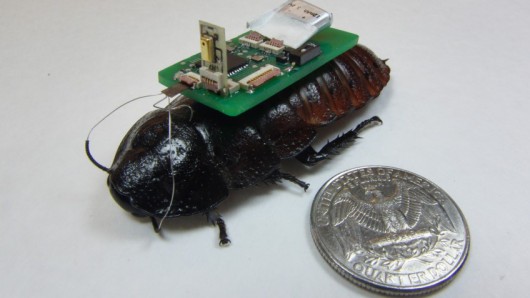
If you're ever trapped in a collapsed building and are calling for help, you might want to think twice before squashing any cockroaches that wander your way – one of them might have been sent to find you. Researchers from North Carolina State University are currently laying the groundwork for such a scenario, by getting cyborg-like "biobot" cockroaches to move towards sounds. Down the road, such insects may be used to locate victims at disaster sites.
We first heard about the biobots a couple of years ago. Developed by a team led by Dr. Alper Bozkurt, each one consists of a Madagascar hissing cockroach equipped with a "backpack" that contains an inexpensive microchip, a wireless receiver/transmitter, and a microcontroller.
That microcontroller is wired into the cockroach’s antennae and cerci. The cerci are sensory organs in the abdomen, that detect air movement in order to warn of approaching predators. When the cerci are instead stimulated by the microcontroller, the cockroach still thinks that something is coming at it from behind, and scuttles forward.
In order to direct that forward movement, either one of the antennae are stimulated. Ordinarily, they’re activated when they brush against unyielding objects, letting the cockroach know that it can’t move in that direction. In this case, when the stimulation comes not from an object but from a small electrical charge, the insect still reacts by changing course.
Previously, both human operators and a Kinect-equipped computer have used that system to steer the biobots by wireless remote control. In the most recent study, however, an array of three-directional microphones was added to each cockroach's backpack. By analyzing the sound detected by each of those mics, software was able to determine the location of the source of that sound. It then activated the biobot's microcontroller accordingly, in order to steer the insect toward that location.
Some cockroaches were also equipped with just a single high-resolution mic. It is hoped that eventually, biobots with those mics could be used to differentiate victims' voices from other noises at disaster sites. Once a voice was detected, the multi-mic biobots could be activated to seek out its source. Although the cockroaches couldn't do much to help those people themselves, rescuers could track them via their transmitters, to establish the whereabouts of the victims. A previous study has already indicated that the biobots can be used to map disaster sites.

 Previous page
Previous page Back to top
Back to top







